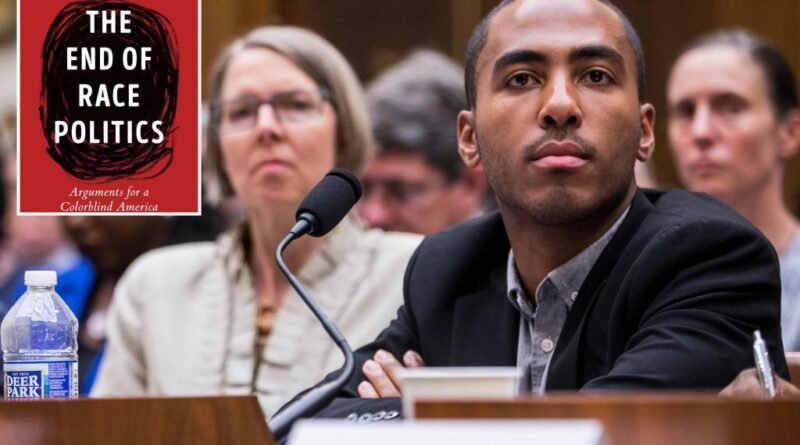Reconsidering Race: Coleman Hughes’ Fresh Perspective

Few political commentators have caught the national spotlight quite like 27-year-old Coleman Hughes, a Columbia University graduate and New Jersey native whose observations on race, class, and politics reveal wisdom and insight far beyond his years. Critical of both the nation’s obsession with race and the reliance on diversity, equity, and inclusion (DEI) programs to redress race-based inequalities, Hughes is the rare young writer of color who rejects progressive “woke” orthodoxies in exchange for hard data – and old-fashioned common sense.
In 2019, Hughes testified before Congress, where he opposed a federal effort to develop a formalized plan for slavery reparations — publicly opposing the far better-known (and far older) author Ta-Nehisi Coates, who has long supported reparations for African Americans. Now Hughes has released “The End of Race Politics: Arguments for a Colorblind America” (Thesis), in which he argues that structural policies to redress America’s racist past — particularly DEI — are only hurting its present. In the excerpt that follows, Hughes explains how America reached this contentious racial reckoning — and suggests that the nation might actually be far more united than our dividers might like us to believe.
The Bush years and early Obama years represented a fairly healthy equilibrium for America on the issue of race. The majority of Americans — both black and white — believed that race relations were good. Then, after 2013, something changed. Around that time American attitudes toward race relations took a nosedive. By 2021 about half as many Americans felt that we were in a good place as felt that way in 2013.
It’s not an exaggeration to say that whatever happened after 2013 represents the biggest setback in American race relations in at least a generation.
So what happened? Why did people’s attitudes toward race relations take a nosedive in 2013? We can rule out a few explanations. It probably was not the election of President Obama, since he presided over five years of good race relations. And it probably wasn’t President Trump either, as the downward trend began three years before he was elected, and doesn’t appear to have reversed itself since his departure from office. As much as we like to blame presidents for everything, the reality is that sweeping social trends have causes that run deeper than a single individual.
We can also rule out the idea that actual racism suddenly increased in 2013. If there had been an uptick in the popularity of white supremacy or an uptick in the number of unarmed black people shot by police, then we might have reason to suspect that there was an increase in racism. But neither of those is the case. Support for white supremacy has been steadily declining for decades, and so has the annual number of police shootings.
The more plausible explanation is that 2013 is about the time that a critical mass of Americans had two pieces of tech: camera-enabled smartphones and social media. The widespread use of social media and smartphones increased the speed at which content could spread throughout the world. But not all content was able to take advantage of this development equally. The ideology I call “neoracism” — which casts whites as an oppressor race and everyone else as victims — was able to take advantage of this development in a way that other ideologies could not.
Here’s an analogy: Imagine that the speed limit on a highway was suddenly raised from 75 mph to 200 mph. Not all cars would be able to take advantage of this change. If you drive a Chevy Spark (with a top speed of 89 mph), the new speed limit change wouldn’t benefit you much. But if you drive a McLaren Speedtail (with a top speed of 250 mph), you’d suddenly be able to travel much faster.
What happened around 2013 is that the speed limit on the information highway was suddenly raised—not by a factor of two or three, but by several orders of magnitude. And it turns out that certain content has a much higher “top speed” than other content. Anything that appeals to our tribal identities, us versus them narratives, or historical grievances travels fast. These pieces of content are the McLarens of the Internet. Anything that emphasizes common humanity, rational analysis, or fact-checking, on the other hand, travels far more slowly. These are the Chevy Sparks.
When Michael Brown was killed by Darren Wilson in Ferguson in 2014, the narrative that a racist cop had killed an unarmed black teenager who had his hands up spread quickly. As far as narratives go, this one tapped into every psychological trigger that would lead people to share it widely: black v. white, historical grievances, violence, and so on. The fact-check of this event — that Michael Brown did not have his hands up, had physically overpowered the officer, punched him, and tried to steal his gun — traveled slowly because it appealed more to reason than to outrage. Indeed it traveled so slowly that it still has not reached the countless individuals who, years later, still believe the mythical version of events. To this day, “Hands Up, Don’t Shoot” remains one of the most popular slogans at Black Lives Matter protests.
Back when all information spread more slowly, the fact-checked version of events could arrive in time to preempt false representations (the Chevy and the McLaren arrived at the same time). But those days are over. In the age of social media, myths, and half-truths can more easily outrun the facts.
Neoracist ideology — because it casts every event as an instance of us versus them, good versus evil, black versus white — has been able to take advantage of the increased speed and decreased quality of the information people circulate. The majority of black Americans pre-2013 believed that race relations were good. Consider the following chart, which tracks the percentage of black Americans who believe that racial discrimination was the main issue causing disparities in housing, jobs, and income:
As late as 2013, a clear majority of black Americans did not think that discrimination was the main driver of racial disparities. That is back when people were judging societal issues mainly by reference to their own lived experience — in addition to a slow-moving information diet that consisted of reading newspapers and watching the news on TV.
Prior to 2013, most blacks and whites in America thought race relations were good. The trend line showed that fewer and fewer blacks every year saw racial discrimination as a big issue. Then everything changed. We saw a tenfold increase in mentions of race and racism — despite every indication that viewpoints about actual racism against blacks were trending downward.
Why, then, did people’s perception of race relations take a nosedive after 2013? The answer is that smartphones and social media changed the speed limit of information — which in turn gave a massive competitive advantage to ideas, information, narratives, and arguments that tap into division, tribalism, and grievances. Neoracism was among the ideologies able to take advantage of this seismic change. Ultimately, this change resulted in an information diet that is less tethered to reality, not more.
Correlational data show that black people who use social media are more likely to report being victims of racial discrimination than black people who don’t. Correlation does not imply causation. But the data, at least, are consistent with the view that social media has caused a major shift in how people view themselves and the world — a shift away from reality and toward paranoia, pessimism, and catastrophizing.
The news doesn’t report on the millions of black people who never encounter racism in their daily lives. Their experiences aren’t newsworthy. The upshot: the media is heavily biased toward reporting emotionally charged stories of racism — stories that create a misperception that racism is a more widespread social problem than it is. It’s important to see the media for what it is: a business—one that aims at increasing views, clicks, and subscriptions. The media has realized that anti-black racism sells, so it highlights anything that can be spun in that direction.
You might object that social media and smartphones have merely made us more aware of the widespread racism that’s actually out there. If this were true, then we’d expect Americans in the age of social media to have an accurate perception of the amount of racism in society. That proposition has been tested and has come back negative. For instance, 54% of “very liberal” Americans — the section of the population most active on social media — believe that over one thousand unarmed black men were killed by the cops in 2019. The real number was twelve. Social media isn’t educating us. It’s miseducating us.
From “The End Of Race Politics: Arguments for a Colorblind America,” by Coleman Hughes, published on Feb. 6 by Thesis, an imprint of Penguin Publishing Group, a division of Penguin Random House, LLC. Copyright (c) 2024 by Coleman Hughes.




